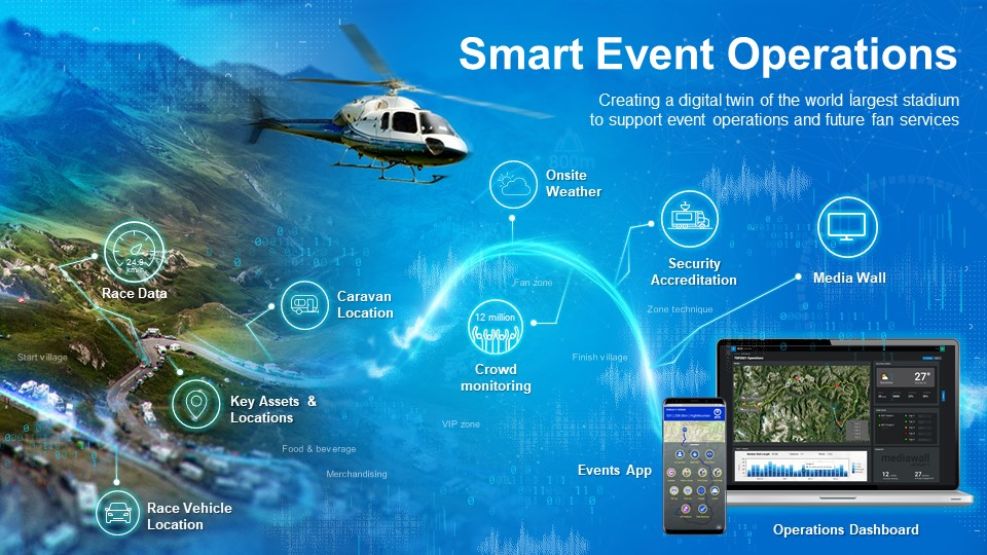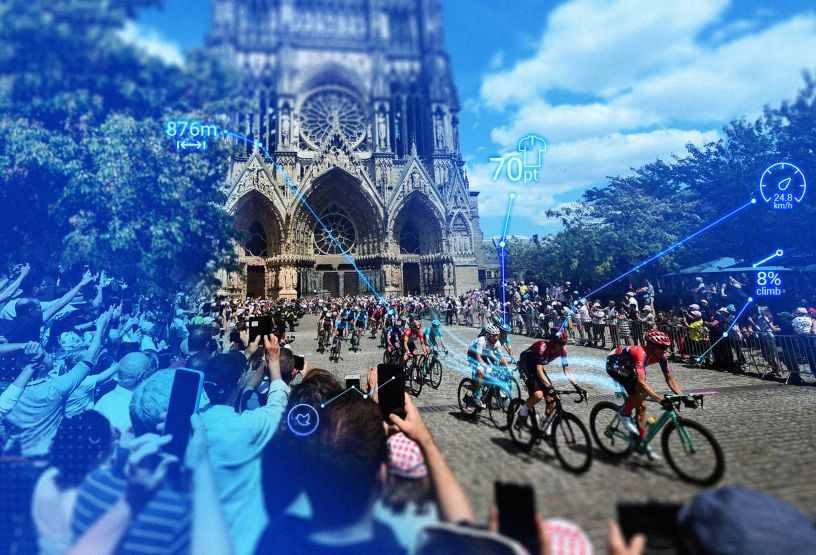-
Featured services
Harness innovation to deliver value
Ensure short-term stability as you design a roadmap for new use cases in your industry with emerging technologies.
Explore Connected Industries -
Services
View all services and productsLeverage our capabilities to accelerate your business transformation.
-
Services
Network as a Service
Popular Products
-
Private 5G
Our turnkey private 5G network enables custom-built solutions that are designed around unique use cases and strategies, and deployed, run and optimized through a full network-as-a-service model.
-
Managed Campus Networks
Our Managed Campus Networks services transform campus networks, corporate area networks and interconnected local area networks, and connect smart places and industries.
-
-
Services
Cloud Services
Popular Products
-
Cloud Migration and Transformation Services
Access the people, processes and technologies you need to deliver cloud migration projects that improve your return on investments.
-
Site Reliability Engineering Services
Get the most from your cloud investments when you harness our Site Reliability Engineering Services to support app development and lifecycle management.
-
-
Services
Edge as a Service
Client stories
-
Penske Entertainment and the NTT INDYCAR SERIES
Together with Penske Entertainment, we’re delivering digital innovations for their businesses – including INDYCAR, the sanctioning body of the NTT INDYCAR SERIES – and venues such as the iconic Indianapolis Motor Speedway, home to the Indianapolis 500.
-
Using private wireless networks to power IoT environments with Schneider Electric
Our combined capabilities enable a secure, end-to-end digital on-premises platform that supports different industries with the benefits of private 5G.
-
-
Services
Technology Solutions
Client stories
-
Services
Global Data Centers
-
Services
Digital Collaboration and CX

IDC MarketScape: Worldwide Datacenter Services 2023 Vendor Assessment
We provide a new kind of intelligent infrastructure to deliver better outcomes through technology.
Get the IDC MarketScape -
-
-
Insights
Recent Insights
-
The Future of Networking in 2025 and Beyond
-
Using the cloud to cut costs needs the right approach
When organizations focus on transformation, a move to the cloud can deliver cost savings – but they often need expert advice to help them along their journey
-
Make zero trust security work for your organization
Make zero trust security work for your organization across hybrid work environments.
-
-

Copilot for Microsoft 365
Everyone can work smarter with a powerful AI tool for everyday work.
Explore Copilot today -
-
Global Employee Experience Trends Report
Excel in EX with research based on interviews with over 1,400 decision-makers across the globe.
Get the EX report -
Discover how we accelerate your business transformation
-
About us
CLIENT STORIES
-
Liantis
Over time, Liantis – an established HR company in Belgium – had built up data islands and isolated solutions as part of their legacy system.
-
Randstad
We ensured that Randstad’s migration to Genesys Cloud CX had no impact on availability, ensuring an exceptional user experience for clients and talent.
-
-
CLIENT STORIES
-
Liantis
Over time, Liantis – an established HR company in Belgium – had built up data islands and isolated solutions as part of their legacy system.
-
Randstad
We ensured that Randstad’s migration to Genesys Cloud CX had no impact on availability, ensuring an exceptional user experience for clients and talent.
-
-
CLIENT STORIES
-
Liantis
Over time, Liantis – an established HR company in Belgium – had built up data islands and isolated solutions as part of their legacy system.
-
Randstad
We ensured that Randstad’s migration to Genesys Cloud CX had no impact on availability, ensuring an exceptional user experience for clients and talent.
-

NTT DATA and HEINEKEN
HEINEKEN revolutionizes employee experience and collaboration with a hybrid workplace model.
Read the HEINEKEN story -
- Careers
Optimizing race organization and fan experiences for the Tour de France
Over the past seven years, we’ve been the Official Technology Partner of the Tour de France and race owners Amaury Sport Organisation (A.S.O.). Together we’re exploring new and innovative ways to leverage technology to drive their digital transformation journey.
This journey is driven by the goal of creating a thoroughly modern race, one that inspires both long-time followers and reaches younger, more digital fans. The data-driven approach allows A.S.O. to not only connect with fans on multiple platforms but also provides new levels of insight into the race. At the same time, they’re digitally transforming race operations, enabling their teams to make faster decisions informed by real-time data, delivered to them wherever they are.
To make this a reality A.S.O. are using technology to reduce complexity, leveraging the power of data to put available resources to best use, ensuring the long-term sustainability of this iconic event.
The process of creating a digitized Tour de France started in 2015, using GPS transceivers to track the location of the cyclists in real-time. Each year we’ve deepened this relationship, working together to find innovative applications of existing technologies and introducing others, including artificial intelligence, machine learning and augmented reality, while continuously creating new ways for broadcasters and fans to interact with the race.
In 2020 we leveraged our platforms to support the Virtual Tour de France when the physical event was delayed because of COVID-19. We introduced an augmented reality application, tapped into the collective capabilities of our global team with a Tour de France Hackfest, and supported the execution of the Tour with a team distributed across five continents.
Creating a digital twin of the Tour de France
In 2021 we’re turning the roads of France into the world’s largest connected stadium, covering all 3,400km of the Tour de France. We’ve created a digital twin of the physical event, mapping all the elements of the race, from the riders through to race vehicles, the route, and the areas around the start and finish of each stage. This provides race organizers with an accurate digital representation of the real world, enabling them to build plans, monitor the race in real-time and anticipate situations using real-world data. This capability is vital in helping them reduce risk and manage their dynamic environment.To achieve this, we’re leveraging a digital fabric of sensors, edge computing devices, networking technologies and applications, all working in concert to provide A.S.O. with the insights they need to optimize race operations and provide fans with deeper insights.
Making data work to support business goals
Data collected from the sensors on the riders’ bikes - combined with information such as weather and historical race statistics - provides us with a real-time view of the race and insights into what might happen on the day. Alongside this data, we’re using other sources of information to provide race organizers with a view of the environment beyond the race. To do this we’re using a broad range of IoT sensors, integrated into a common platform and mapped against a geo-location model of the stage. This enables real-time visibility of key locations and assets, monitoring of crowd density or congestion, COVID-19 contact tracing, and real-time updates of caravan and race arrival times. The real-world and real-time data provides race organizers with the insights needed to deliver a safe and secure race environment for riders, teams and fans.
An example of this in action is our ability to use real-time video feeds to monitor crowd density. The footage from the high-definition cameras is monitored by an AI-powered system and can alert organizers when one area is becoming overcrowded, enabling them to direct fans to less crowded areas. While this is useful intelligence at any event, COVID-19 prevention regulations make this critical data for today’s event organizers.
In access-controlled areas, integrating access control with information from accreditation systems allows organizers to do contact tracing should there be a confirmed case, enabling them to monitor people’s movements and alert others who may have come into contact with them.
Providing visibility for the officials in the race vehicles
Our tracking solution uses a diverse network fabric to get data from the bicycles to the end of the race.
This year we’re not just receiving data from the race, but also sending back information to the race vehicles to solve another pressing challenge for race organizers. While it’s one thing to get information about the status of the race out to the rest of the world, getting vital race data back to the race vehicles is a critical challenge. Each day the race organizers have vehicles on the road supporting the race commissaires, medical personnel and their own team members. Until this year they’ve been reliant on race radio for all their information, unable to get a comprehensive view of the state of the race given the limited mobile network coverage available in remote areas the race travels through.
Working together with A.S.O. and their partners, we co-innovated a solution that can be used by race commissaires to view live broadcast footage and race telemetry data. With edge computing capabilities in the broadcast truck at the end of the race, we combine a broadcast feed and critical race information into a signal that’s sent from the edge to the vehicles in a compressed package over the same network used by the broadcast team to transmit the live race footage.
Richer fan engagement
As part of our combined innovation around fan engagement, this year will see the introduction of a data-rich media wall and the expansion of our augmented reality app at the Tour de France. A key focus over the past seven years has been finding new ways to use data to tell stories, enabling A.S.O. to reach new audiences. Leveraging our experience in telling stories with data that’s been built up through our work with broadcasters and on our @letourdata social media channel, we’re integrating real-time race data, insights, and live footage and delivering it to fans at the race and across the globe. In the VIP areas in the Arrival and Departure villages, the NTT Media Wall provides fans with real-time data visualizations and race updates.The NTT Media Wall is delivered through the NTT Services Portal which also delivers real-time insights to our clients on the status of the services and solutions we provide to them.
The same underlying data is being used to power the 3D race tracker, an augmented reality app for fans, enabling them to view a real-time map of the race in 3D, completely independent of their location - be it at the race or watching from anywhere in the world.

